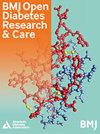循环代谢组标记物与 1 型糖尿病微血管并发症总体负担的关系
IF 3.7
2区 医学
Q2 ENDOCRINOLOGY & METABOLISM
引用次数: 0
摘要
导言:糖尿病视网膜病变(DR)、糖尿病肾病(DKD)和远端对称性多发性神经病变(DSPN)具有共同的病理生理学特征,会增加早期死亡的风险。研究设计和方法 在 1 型糖尿病成人患者中,评估了 49 种以前与 DR 或 DKD 相关的代谢物与 DSPN 存在的关系。使用线性回归模型评估了与所有三种并发症的存在有重叠意义的代谢物与微血管负担严重程度的关系(并发症数量的加和,即 DKD±DR±DSPN 的存在)。随后,对进展到终点的相同代谢物进行评估:使用 Cox 模型评估软性微血管事件(白蛋白尿分级进展、估计肾小球滤过率 (eGFR) 下降≥30% 或 DR 分级的任何进展)、硬性微血管事件(进展为增殖性 DR、慢性肾衰竭或 eGFR 下降≥40%)以及硬性微血管或大血管事件(硬性微血管事件、心血管事件(心肌梗死、中风或动脉介入)或心血管死亡率)。所有模型均根据性别、基线年龄、糖尿病病程、收缩压、HbA1c、体重指数、总胆固醇、吸烟和他汀类药物治疗情况进行了调整。结果 接受调查的全组共有 487 人。平均(标清)随访时间为 4.8(2.9,5.7)年。横断面队列中有 202 名参与者掌握了基线生物血红素测定法。8种代谢物与DR、DKD和DSPN的存在明显相关,6种代谢物与微血管负担的严重程度相关。在整个队列的纵向分析中,3,4-二羟丁酸(DHBA)、2,4-DHBA、核糖酸、甘氨酸和核糖醇水平较高与粗略模型和调整模型中事件的发生有关。在传统的风险因素模型中加入 3,4-DHBA、核糖酸和甘氨酸可提高对硬性微血管事件的识别能力。结论 虽然需要进行前瞻性研究来直接评估这些标记物的预测能力,但我们的研究结果加强了临床代谢组学在慢性 1 型糖尿病并发症风险评估中的作用。如有合理要求,可提供相关数据。根据丹麦 GDPR 法规,本研究中生成和分析的数据集不对外公开。如提出合理要求,可向通讯作者索取经整理的匿名数据集。本文章由计算机程序翻译,如有差异,请以英文原文为准。
Circulating metabolomic markers in association with overall burden of microvascular complications in type 1 diabetes
Introduction Diabetic retinopathy (DR), diabetic kidney disease (DKD) and distal symmetric polyneuropathy (DSPN) share common pathophysiology and pose an additive risk of early mortality. Research design and methods In adults with type 1 diabetes, 49 metabolites previously associated with either DR or DKD were assessed in relation to presence of DSPN. Metabolites overlapping in significance with presence of all three complications were assessed in relation to microvascular burden severity (additive number of complications—ie, presence of DKD±DR±DSPN) using linear regression models. Subsequently, the same metabolites were assessed with progression to endpoints: soft microvascular events (progression in albuminuria grade, ≥30% estimated glomerular filtration rate (eGFR) decline, or any progression in DR grade), hard microvascular events (progression to proliferative DR, chronic kidney failure, or ≥40% eGFR decline), and hard microvascular or macrovascular events (hard microvascular events, cardiovascular events (myocardial infarction, stroke, or arterial interventions), or cardiovascular mortality), using Cox models. All models were adjusted for sex, baseline age, diabetes duration, systolic blood pressure, HbA1c, body mass index, total cholesterol, smoking, and statin treatment. Results The full cohort investigated consisted of 487 participants. Mean (SD) follow-up was 4.8 (2.9, 5.7) years. Baseline biothesiometry was available in 202 participants, comprising the cross-sectional cohort. Eight metabolites were significantly associated with presence of DR, DKD, and DSPN, and six with additive microvascular burden severity. In the full cohort longitudinal analysis, higher levels of 3,4-dihydroxybutanoic acid (DHBA), 2,4-DHBA, ribonic acid, glycine, and ribitol were associated with development of events in both crude and adjusted models. Adding 3,4-DHBA, ribonic acid, and glycine to a traditional risk factor model improved the discrimination of hard microvascular events. Conclusions While prospective studies directly assessing the predictive ability of these markers are needed, our results strengthen the role of clinical metabolomics in relation to risk assessment of diabetic complications in chronic type 1 diabetes. Data are available upon reasonable request. The datasets generated and analyzed during the current study are not publicly available due to Danish GDPR legislation. Scrambled, anonymized datasets could be available from the corresponding author on reasonable request.
求助全文
通过发布文献求助,成功后即可免费获取论文全文。
去求助
来源期刊

BMJ Open Diabetes Research & Care
Medicine-Endocrinology, Diabetes and Metabolism
CiteScore
9.30
自引率
2.40%
发文量
123
审稿时长
18 weeks
期刊介绍:
BMJ Open Diabetes Research & Care is an open access journal committed to publishing high-quality, basic and clinical research articles regarding type 1 and type 2 diabetes, and associated complications. Only original content will be accepted, and submissions are subject to rigorous peer review to ensure the publication of
high-quality — and evidence-based — original research articles.
 求助内容:
求助内容: 应助结果提醒方式:
应助结果提醒方式:


